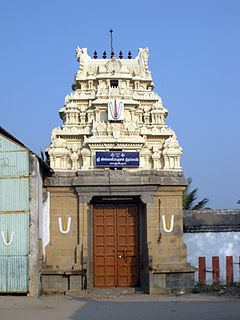Other names Toopul | Architectural style Dravidian architecture | |
 | ||
Tooppul, or Tiruththanka (also called Deepaprakasa Perumal Temple) located in Kanchipuram in the South Indian state of Tamil Nadu, is dedicated to the Hindu god Vishnu. Constructed in the Dravidian style of architecture, the temple is glorified in the Divya Prabandha, the early medieval Tamil canon of the Azhwar saints from the 6th–9th centuries AD. It is one of the 108 Divyadesam dedicated to Vishnu, who is worshipped as Deepa Prakasar and his consort Lakshmi as Maragathavailli.
Contents
The temple is believed to have been expanded during the Medieval Cholas and Vijayanagar kings. The temple has inscriptions on its walls dating from the period of Rajaraja Chola III (1223 CE). A granite wall surrounds the temple, enclosing all the shrines and two bodies of water. There is a two-tiered rajagopuram, the temple's gateway tower, in the temple.
Deepaprakasar is believed to have appeared to Brahma. Six daily rituals and three yearly festivals are held at the temple, of which the Brahmotsavam festival, celebrated during the Tamil month of Puratassi (September - October), being the most prominent. The temple is maintained and administered by the Hindu Religious and Endowment Board of the Government of Tamil Nadu.
Legend
As per Hindu legend, once there was an argument between Saraswathi, the consort of Brahma and Lakshmi on superiority. They went to Indra, the king of celestial deities. Indra judged Lakshmi as superior and not satisfied with his argument, Saraswathi went to her husband, Brahma. He also chose Lakshmi to be the superior one. Saraswathi was unhappy with the decision and decided to stay away from Brahma. Brahma did a severe penance praying to Vishnu and did an Aswametha Yagna. Saraswathi was still angry that the yagna, which usually is done along with consorts was done alone by Brahma. She tried to disrupt the penance, but Vishnu interfered. Another version of the legend states that Saraswathi sent raakshakas to spoil the penance, which was spoiled by the stream of light from Vishnu. Since Vishnu appeared as light to overcome the darkness of the situation, he was termed Deepaprakasa Perumal.
Vedanta Desika (1268 - 1369 CE) was an ardent devotee of Deepa Prakasa Temple at Thoppul. The devotion of Desika is mentioned in Varadaraja Panchasat in 50 verses.
Architecture
The temple is located in Vishnu Kanchi along with most other Vishnu temples in Kanchipuram. The temple has a three-tiered rajagopuram, the gateway tower. The temple has a rectangular plan surrounded by brick walls and has two precincts. The central shrine of the temple has the image of the presiding deity, Deepaprakasa Peruam in sitting posture. There are shrines for Lakshmi Hayagriva, Andal, Vedanta Desika and Alwars. It is the birthplace of Vedanta Desika. There is a separate shrine for Lord Hayagreeva along with Vedanta Desika. The temple tank, Saraswathi Theertham, is located outside the premises. A shrine is dedicated to Vedanta Desika facing South is seen in the temple. The icon of Desika is believed to be installed by his son Nayinar Varadhachariar. The image is seen sporting Abhaya Mudra (palm displayed in attitude of protection). The temple practises Vaigasana Agama.
Religious importance
The temple is revered in Nalayira Divya Prabandham, the 7th–9th century Vaishnava canon, by Thirumangai Azhwar in one hymn. The temple is classified as a Divyadesam, one of the 108 Vishnu temples that are mentioned in the book. The temple is one of the 14 Divyadesams in Kanchipuram. The temple is believed to be the place where Brahma performed penance seeking the wishes of Vishnu and one of the few places where Brahma worshiped Vishnu. The temple is counted one among the four temples in Kanchipuram that include Yathothkari Perumal Temple, Ashtabhujagara Perumal temple and Varadaraja Perumal Temple where the legend of Brahma performing penance is associated. The temple is also revered in the verses of Manavala Maamunigal, Vedanata Desikar and Pillai Perumal Iyengar.
Festivals and religious practices
The temple follows the traditions of the Vadakalai sect of Vaishnavite tradition and follows vaikanasa aagama. The temple priests perform the pooja (rituals) during festivals and on a daily basis. As at other Vishnu temples of Tamil Nadu, the priests belong to the Vaishnavaite community, a Brahmin sub-caste. The temple rituals are performed six times a day: Ushathkalam at 7 a.m., Kalasanthi at 8:00 a.m., Uchikalam at 12:00 p.m., Sayarakshai at 6:00 p.m., Irandamkalam at 7:00 p.m. and Ardha Jamam at 10:00 p.m. Each ritual has three steps: alangaram (decoration), neivethanam (food offering) and deepa aradanai (waving of lamps) for both Deepaprakasar and Maragathavalli. During the last step of worship, nagaswaram (pipe instrument) and tavil (percussion instrument) are played, religious instructions in the Vedas (sacred text) are recited by priests, and worshippers prostrate themselves in front of the temple mast. There are weekly, monthly and fortnightly rituals performed in the temple.
The Brahmostavam festival during the Tamil month of Puratasi (September - October) is the major festival celebrated in Vedanta Desika shrine. During the festival, the festival image of Desikar is carried to the Varadaraja Perumal Temple. Special worship practises and rituals are followed during the occasion. During the Brahmostavam in Varadaraja Perumal Temple during the Tamil month of Vaikasi(May - June), the festival image of Varadaraja Perumal is brought to the shrine of Vedanta Desika on three different days.
